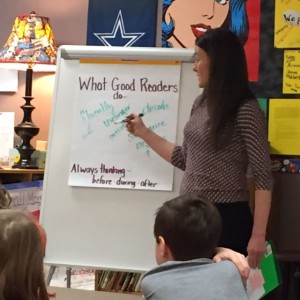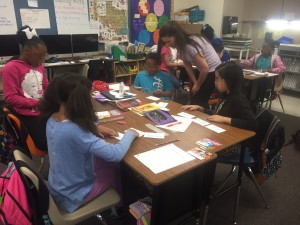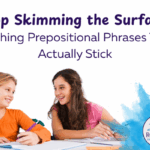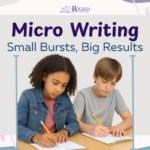** Contact us if you would like Rogers Education Consulting to come to your campus with engaging, evidence-based, and practical professional development **
 So many times in education we, as teachers, are bombarded with buzz words. These words will eventually become white noise, words you expect to hear in an academic setting, but you no longer think about or process what they mean. In fact, if I think back, most of these buzz words were never really explained or made practical to the teachers, so we were never really sure if we were implementing whatever it was we were buzzing about or not! Some buzz words that are common now are schema, explicit instruction, scaffolding, and rigor. I finally realized that, in my workshops, I constantly referred to explicit instruction and then just moved on. After many questions from participants, I realized that I am doing what was always done to me, dropping words without explanation.
So many times in education we, as teachers, are bombarded with buzz words. These words will eventually become white noise, words you expect to hear in an academic setting, but you no longer think about or process what they mean. In fact, if I think back, most of these buzz words were never really explained or made practical to the teachers, so we were never really sure if we were implementing whatever it was we were buzzing about or not! Some buzz words that are common now are schema, explicit instruction, scaffolding, and rigor. I finally realized that, in my workshops, I constantly referred to explicit instruction and then just moved on. After many questions from participants, I realized that I am doing what was always done to me, dropping words without explanation.
Explicit instruction has proven to provide the largest gains in student learning, as was scientifically proven in two studies by Marin & Halpern 2011. There doesn’t seem to be one clear definition of explicit instruction, but all definitions include the words clear, unambiguous, and direct. When I discuss explicit instruction with the teachers I work with, I mainly focus on 5 points.
- Instruction provided to the students should be focused on one new skill. While you might spiral in other
 skills students have already been taught, it’s a good idea to remain focused on one NEW skill. By focused, I mean really targeting one skill or strategy in your instruction. If I am teaching the students how to make inferences about characters in the story, I might spiral back to asking questions and making predictions, but I will be targeting making inferences. It is important to break the strategy or skill into manageable pieces, so students are building upon success. In other words, making inferences is a huge concept and there are many times within one read that a reader would make inferences. So instead of trying to cover all of inferencing in one lesson, focus on one type or way to make inferences. For example, I might focus in on making inferences about a character’s actions.
skills students have already been taught, it’s a good idea to remain focused on one NEW skill. By focused, I mean really targeting one skill or strategy in your instruction. If I am teaching the students how to make inferences about characters in the story, I might spiral back to asking questions and making predictions, but I will be targeting making inferences. It is important to break the strategy or skill into manageable pieces, so students are building upon success. In other words, making inferences is a huge concept and there are many times within one read that a reader would make inferences. So instead of trying to cover all of inferencing in one lesson, focus on one type or way to make inferences. For example, I might focus in on making inferences about a character’s actions. - This focused instruction should clearly explain the how, when, and why of using the skill. It’s important for students to know why they are being asked to learn a strategy or skill. For the making inferences example, I would tell the students we have to make inferences about the characters in stories because, when I connect to and understand the characters, I will understand the story on a deeper level. Additionally, characters typically move the plot along and hold the answer to the theme, so it’s a good idea to learn more about them. Students must also be told how to use a strategy or skill. We should not assume they know how to do it already or that by simply defining the skill the students will be able to perform the action. I explain to students, that in order to make an inference about a character, I must use text evidence and apply my background knowledge of the situation to make a guess about how the character is feeling or how they might react. This would be followed by a more specific example from a book we are reading as a class. The last part is to make sure and explain when you would like them to use the strategy or skill. If we don’t tell students when we want them to use the skill, they will only ever use it when we ask them to. We want students to be independent and capable of using skills when needed and not rely on us all the time. I teach students that every time a major interaction happens between characters in a story, I want you to stop and make an inference about the character. I want you to think about how the character is feeling and what the character might do. How is this influencing the plot of the story?
- Explicit instruction should be modeled for the students. Modeling is a type of scaffold that helps students
 understand how to work through a strategy. Modeling is exactly what it sounds like: demonstrating or showing students how to do something. Typically in reading, we model by using a think-aloud. We read a story out loud to the students, stopping every so often to “think-aloud” which will demonstrate what is going on inside our heads as we read. For example, I might read a little bit of a story, stop, and say, “I am noticing that the tiger in this story is getting frustrated, because he said he can’t take it anymore and I know that when I get to that frustration level I just want to run, to leave the situation. I think that tiger is going to run away and leave the town behind.” By saying this out loud, I am modeling or demonstrating clearly for the students how to make an inference about a character. This would go on throughout the story, with hopes that students would emulate this thinking in their own reading.
understand how to work through a strategy. Modeling is exactly what it sounds like: demonstrating or showing students how to do something. Typically in reading, we model by using a think-aloud. We read a story out loud to the students, stopping every so often to “think-aloud” which will demonstrate what is going on inside our heads as we read. For example, I might read a little bit of a story, stop, and say, “I am noticing that the tiger in this story is getting frustrated, because he said he can’t take it anymore and I know that when I get to that frustration level I just want to run, to leave the situation. I think that tiger is going to run away and leave the town behind.” By saying this out loud, I am modeling or demonstrating clearly for the students how to make an inference about a character. This would go on throughout the story, with hopes that students would emulate this thinking in their own reading. - Instruction should be meaningful to students. When information is presented in context students will be more actively engaged. They are more apt to see the connection and meaning behind learning. In addition, new information should be connected to students prior knowledge. When we, even adults, learn new information it is important to “file” this information with already known information. Anderson & Pearson (1984) found that when we activate schema and begin to attach reading to students’ prior knowledge, their comprehension levels improve. If I were to read a story about a character to specifically teach making inferences about characters, we would first think about the way they act on the playground. I would explain and model different actions on the playground and what that means and what they think the student would do. This will activate their schema and begin helping them make inferences about the characters in the book based off of their own background knowledge.
- Finally, There needs to be a high level of teacher-student interaction. Just because the teacher tends to be the “sage on the stage” during explicit instruction, doesn’t mean the students should be just sitting there passively listening. As the teacher, you need to constantly check in with students to see what they’re learning and how they are processing this information. Have students turn and talk, ask students questions, try doing the strategy together, etc. The more interaction with the students, the more actively engaged they are in learning.

While there is more to explicit instruction, this is a great place to start. Students will thrive from clear, focused, modeled, and meaningful instruction.
Anderson, R. C., & Pearson, P. D. (1984). A schema-theoretic view of basic processes in reading. In P. D. Pearson, R. Barr, M. L. Kamil, & P. Mosenthal (Eds.), Handbook of reading research (pp. 255-292). New York: Longman.
Marin, L. M., & Halpern, D. F. (2011). Pedagogy for developing critical thinking in adolescents: Explicit instruction produces greatest gains.Thinking Skills and Creativity, 6(1), 1-13.



I have always learned something new when participating in one of Jessica rogers PD sessions. Her clear instructions and easy to understand strategies are always east to turn around for instruction. Thanks Jessica rogers!
Thank you! I really do try to make research practical for busy teachers!